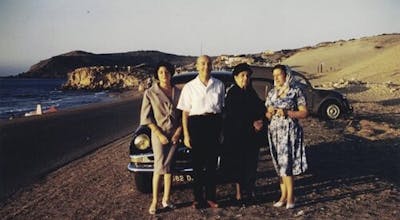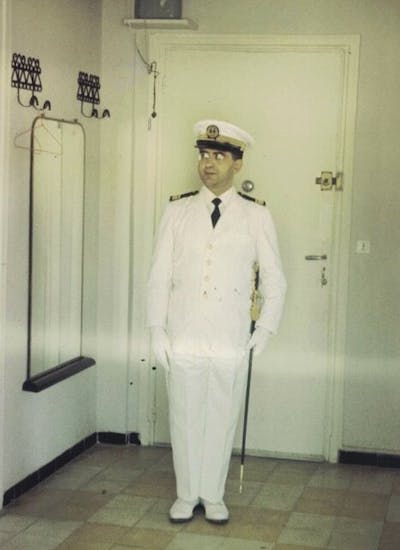Shared by Michel Thouati


Born in Oran, Algeria and raised on French naval bases around the world, Michel Thouati spent long stretches of his childhood living far away from his extended family. In a navy family, he explains, “You live away most of the year and then you go spend lots of time with them when you can.” For Michel, that meant weeks-long visits, often in the summer, with his family in Nice along France’s coast.
The family also made the journey to France for Passover when they could, to celebrate with Michel’s maternal grandparents Laure Orovida Benoliel and Robert Josue Benoliel, and countless other relatives. The cooking leading up to the holiday took days with different aunts and uncles preparing dishes they were known for. And, at Seder, “The table was two or three tables, because there were so many dishes,” says Michel.
“They had so many recipes it was unbelievable,” he adds. The menu changed year to year, featuring generations-old Sephardic recipes. Lamb was always part of the meal, often served with peas, artichoke hearts, lemon, and honey.
Vegetables and fruit were also integral to the meal. To start there might be an orange salad with salt-cured black olives, and a green salad of shaved fennel with garlic and lemon served as an intermezzo just before tea with mint and pine nuts. To accompany the meal, there was always matzo. “In my grandmother's time, we used thick, round matzo… made with orange water,” adds Michel. “Just looking at the table was wonderful.”
The rich and broad recipe repertoire in Michel’s family is unique to a group of Sephardic Jews who have resided in the western Mediterranean for centuries. During the Inquisition, part of Michel’s family, he says, “went to the closest place they could go, which was Tétouan,” a city along Morocco’s northern coast. Over the coming centuries they would jump back and forth between the southern tip of western Europe and the northwestern edge of Africa.
In the 1700s, they went to Gibraltar, and then to Oran, along Algeria’s coast in the late 1800s and then to France. Often, the moves were driven by antisemitism. In the 20th century, Michel explains, his grandparents left France in 1941 “and barely escaped with their lives by leaving all their possessions behind. Then, in 1961 they left Algeria in the same manner.” Despite the movement, he says, his family “always remained within a Judeo Spanish community that kept the closest linkages,” to the traditions, customs, and recipes that pre-date the Inquisition.
Recipes in Michel’s family are more than the dishes that appear on the table; they are stories. “My great-grandmother would sometimes give ‘instructions’ or tell cooking stories to my grandmother and great-uncles and -aunts at cooking time, and they would all talk about how the two previous generations used to cook,” Michel says. “So I was hearing cooking gossip from the 1850s or even earlier.”
Michel started to learn the family recipes when he was 8- or 9-years-old and visiting his grandparents, who he says were like a second set of parents to him. His grandmother Laure showed him techniques for making sofrito, how to prepare the sabbath stew dafina, and couscous.
His culinary education continued in his early 20s. While Michel was pursuing graduate studies in the U.S., his grandfather Robert passed away. Living on a small budget, Michel hadn’t returned home to France in a long time and “I felt horribly guilty,” he says. “I swore that I would always see my grandmother at least once a year.” During his annual pilgrimage to see her, they would cook together everyday — it was a way for them to spend time together. Without planning it, it was also a way for Michel to absorb the family traditions.
As a parent today, Michel is documenting those recipes for his children. He already has 100 written down and is working on 150 more. “I’m hoping that if I live long enough, I’ll probably end up with 350 or 400 recipes and that they will be really good examples to my children of how my family used to cook,” he says.
At Passover in the Bay Area where he now lives, Michel continues to make the elaborate family table, though scaled down for a family of four. He explains: “My goal is that my sons keep the link open to traditions of the past generations…. I don't want to be the one who will let the family traditions die.”


